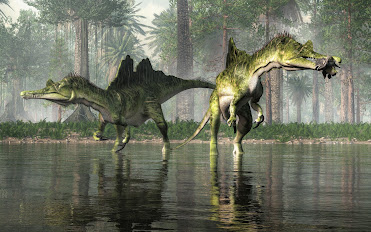 |
| Aioloceras besairiei (Collingnon, 1949) |
Madagascar has some of the most spectacular of all the fossil specimens I have ever seen. This beauty is no exception. The shell has a generally small umbilicus, arched to acute venter, and typically at some growth stage, falcoid ribs that spring in pairs from umbilical tubercles, usually disappearing on the outer whorls. I had originally had this specimen marked as a Cleoniceras besairiei, except Cleoniceras and Grycia are not present in Madagascar.
The beauty you see here measures in at a whopping 22 cm, so quite a handful. This specimen is from the youngest or uppermost subdivision of the Lower Cretaceous. I'd originally thought this locality was older, but dating reveals it to be from the Lower Albian, so approximately 113.0 ± 1.0 Ma to 100.5 ± 0.9 Ma.
Aioloceras are found in the Cretaceous of Madagascar at geo coordinates 16.5° S, 45.9° E: paleo-coordinates 40.5° S, 29.3° E.; and in four localities in South Africa: at locality 36, near the Mzinene River at 28.0° S, 32.3° E: paleo-coordinates 48.6° S, 7.6° E.
If you happen to be trekking to Madagascar, know that it's big. It’s 592,800 square kilometres (or 226,917 square miles), making it the fourth-largest island on the planet — bigger than Spain, Thailand, Sweden and Germany. The island has an interesting geologic history.
Plate tectonic theory had its beginnings in 1915 when Alfred Wegener proposed his theory of "continental drift."
There have been few attempts apart from McKinley’s (1960) comparison of the Karoo succession of southwestern Tanzania with that of Madagascar to follow the famous geological precept of “going to sea.” One critical reason is that although there may be a bibliography of several thousand items dealing with Madagascan geology as Besairie (1971) claims, they are items not generally available to the general public. The vital information gained of the geology of the offshore area by post-World War II petroleum exploration has remained largely proprietary.
We do know that Madagascar was carved off from the African-South American landmass early on. The prehistoric breakup of the supercontinent Gondwana separated the Madagascar–Antarctica–India landmass from the Africa–South America landmass around 135 million years ago. Madagascar later split from India about 88 million years ago, during the Late Cretaceous, so the native plants and animals on the island evolved in relative isolation.
 |
| Red-Tailed Lemurs, Waiwai & Hedgehog |
Today, beautiful outcrops of wonderfully preserved fossil marine fauna hold appeal for me. The material you see from Madagascar is distinctive — and prolific.
Culturally, you'll see a French influence permeating the language, architecture and legal process. There is a part of me that pictures these lovely Lemurs chatting away in French. "Ah, la vache! Regarde le beau fossile, Hérissonne!"
We see the French influence because good 'ol France invaded sleepy Madagascar back in 1883, during the first Franco-Hova War. Malagasy (the local Madagascarian residents) were enlisted as troops, fighting for France in World War I. During the Second World War, the island was the site of the Battle of Madagascar between the Vichy government and the British. By then, the Malagasy had had quite enough of colonization and after many hiccuping attempts, reached full independence in 1960. Colonization had ended but the tourist barrage had just begun. You can't stop progress.
If you're interested in learning more about this species, check out the Treatise on Invertebrate Paleontology, Part L (Ammonoidea). R.C. Moore (ed). Geological Soc of America and Univ. Kansas Press (1957), p L394. Or head over to look at the 2002 paper from Riccardi and Medina. 2002. Riccardi, A., C. & Medina, F., A. The Beudanticeratinae and Cleoniceratinae (Ammonitina) from the Lower Albian of Patagonia in Revue de Paléobiologie - 21(1) - Muséum d’Histoire Naturelle de la ville de Genève, p 313-314 (=Aioloceras besairiei (COLLIGNON, 1949). You have Bertrand Matrion to thank for the naming correction. Good to have friends in geeky places!
Collignon, M., 1933, Fossiles cenomaniens d’Antmahavelona (Province d’ Analalave, Madagascar), Ann. Geol. Serv. Min. Madagascar, III, 1934 Les Cephalopods du Trias inferieur de Madagascar, Ann. Paleont. XXII 3 and 4, XXII 1.
Besairie, H., 1971, Geologie de Madagascar, 1. Les terrains sedimentaires, Ann. Geol. Madagascar, 35, p. 463.
J. Boast A. and E. M. Nairn collaborated on a chapter in An Outline of the Geology of Madagascar, that is very readable and cites most of the available geologic research papers. It is an excellent place to begin a paleo exploration of the island.
If you happen to parle français, check out: Madagascar ammonites: http://www.ammonites.fr/Geo/Madagascar.htm
























.jpg)


.png)

